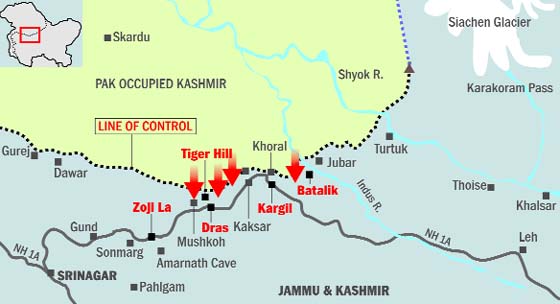Kaobal Gali-Mushkoh Valley opens up for tourists
Context
In the past, Pakistan used to regularly shell the high-altitude passes of the Gurez valley in north Kashmir, which is now off-limits to people. It is now prepared to link up with the 1999 war’s battleground, the Mushkoh valley in Ladakh’s Drass Sector in Kargil. The 130-kilometer road is now open to tourists. The two valleys are connected by Kaobal Gali, which is the highest pass in Gurez at 4,166.9 meters.
Where is Kaobal Gali-Mushkoh Valley situated?
- Kaobal Gali is a high mountain pass in the Kargil district of Jammu and Kashmir.
- It links the Mushkoh Valley in Drass, Ladakh, with the Tulail Valley in Gurez.
- The westernmost portion of Ladakh, which is in the Jammu and Kashmir Union region that is managed by India, is where you’ll find the Mushkoh Valley.
- The region is referred to as the Wild Tulip Valley.
- Kaobal Gali, which is 13,671 feet above sea level, is a restricted and hazardous pass. It offers a different path from Kashmir to Ladakh. Currently, only 4×4 vehicles can reach the pass, although plans exist to make it accessible to tourists.
What is the historical background behind the valley?
- Historical Trade Routes: The Gurez Valley has long been a vital commercial route linking the Kashmir Valley and Central Asia. It was a part of the Silk Road network from antiquity, which promoted trade and cross-cultural interaction.
- Conflict and Relocation: Conflict and military activity have occurred in the valley at various times, particularly during the Kargil War in 1999 and the India-Pakistan Wars. According to the evidence presented about shelling from Pakistan, such hostilities have resulted in population relocation and poverty.
- India and Pakistan engaged in combat in the Kargil War in 1999. In the end, the conflict was won by India.
- For India’s military and its citizens, the Kargil War is of utmost importance. It demonstrated to the rest of the world that India is strong enough to defend its national sovereignty.
What is the cultural significance of the Valley?
- A wide variety of ethnic and religious groups, including Kashmiri Muslims, Gujjars, Bakarwals, and others, have lived in the valley.
- The region has a rich cultural heritage as a result of this variety.
What is the strategic significance of the place?
- Gurez Valley has had strategic significance because of its proximity to the Line of Control (LoC) and the border with Pakistan.
- of particular during times of hostilities and conflict, it has been a focal point of tensions and disputes between India and Pakistan.
- Article 370 of the Indian Constitution, which gave the state of Jammu and Kashmir particular autonomy, was repealed by the Indian government in 2019.
- As a result of this choice, the area was divided into the Jammu & Kashmir and Ladakh Union Territories.
- Now included in this updated administrative framework is Gurez Valley.
How is tourism going to impact the valley?
- Economic Development: The local economy can benefit greatly from tourism. For locals, it opens up employment prospects in the tourism, transportation, and guiding industries. This may lessen local unemployment and poverty.
- Infrastructure Improvement: The increased number of visitors frequently calls for the infrastructure—including the roads, lodgings, dining establishments, and recreational facilities—to be improved. This could result in the valley’s general infrastructure developing, which would be advantageous to both visitors and inhabitants.
- Cultural Exchange: By allowing visitors to connect with locals, tourism may foster cultural exchange and understanding. This may result in the promotion and preservation of the valley’s distinctive traditions and cultural heritage.
- Income generation: Selling their wares to tourists can help local craftsmen and handicraft manufacturers. Traditional arts and crafts, such as handcrafted textiles and other items, can find a market among travellers looking for genuine mementoes.
- Revenue Generation: Taxes, licenses, and admission fees can all help the local government make money from tourism. The infrastructure and growth of the valley can both benefit from this money.
Conclusion
In conclusion, it is thought that the Gurez-Drass road opening to tourists is a result of the peace accord between India and Pakistan. The Gurez Valley has seen a sharp rise in tourism as a result of this development, giving visitors the chance to see a place with unique characteristics including log house settlements, a variety of species, and breathtaking landscapes.





